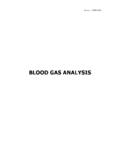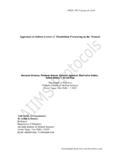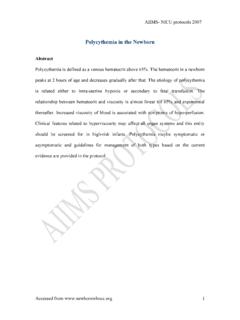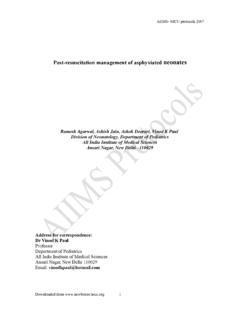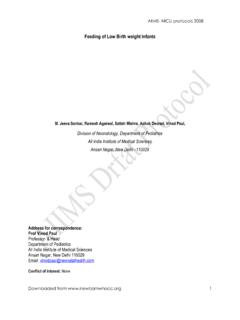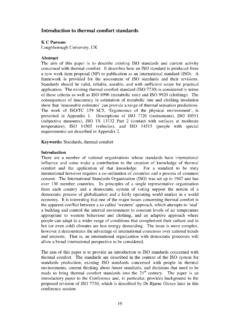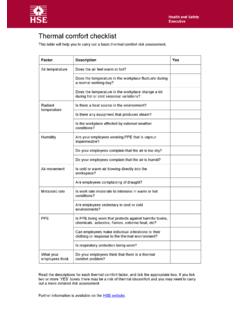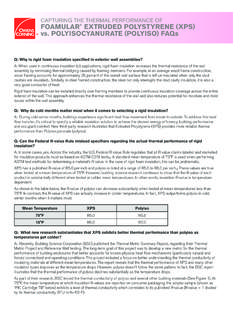Transcription of THERMAL MANAGEMENT - Newbornwhocc
1 THERMAL MANAGEMENT . A newborn baby is homeothermic, but his ability to maintain his body temperature can be easily overwhelmed by environmental temperatures. THERMAL protection of the newborn is a set of continuing measures, which starts at birth, to ensure that he maintains a body temperature of C to C. (Table 1).1 According to NNPD 2002-2003, incidence of hypothermia among extramural babies was %.2. Table 1: Temperature ranges Normal axillary temperature C. Mild hypothermia or cold stress C. Moderate hypothermia Serve hypothermia <32 C. Hyperthermia > C. Thermoneutral environment (TNE). TNE refers to a narrow range of environmental temperature at which the basal metabolic rate (BMR) of the baby is at a minimum, oxygen consumption is at least and baby maintains its normal bodt temperature is called thermoneutral range of Range of neutral temperature varies accordingly for the gestation and postnatal age (Table 2).
2 As opposed to TNE, thermoregulatory environment refers to environmental temperature beyond TNE. range, at which baby would be able to maintain its body temperature but by increasing its BMR. The infants therefore should be kept in TNE so that their energy is utilized for growth and other vital functions. Table 2: Thermoneutral zone Weight of the Recommended ambient temperature baby 35*C 34*C 33*C 32*C. Less than 1500 g 1 to 10 days old 11 days to 3 wk 3 wk to 5 wk old More than 5 wk old old 1500 to 1999 g 1 to 10 days old 11 days to 4 wk More than 4 wk old old 2000 to 2499 g 1 to 2 days old 3 days to 3 wk old More than 3 wk old D2500 g or more 1 to 2 days old 3 days old or more Recording temperature It is not necessary to measure the temperature of healthy newborn babies routinely, particularly when the warm chain is strictly followed.
3 Temperature should be monitored every 1-2 hour for a baby with serious illness, twice daily for babies weighing between 1500 to 2499 gm, four times daily for babies below 1500 gm and once a day for other babies who are doing well. Methods of recording temperature Touch method Abdomen skin temperature is assessed by touch with dorsum of hand. Abdominal temperature is representative of the core temperature. Baby's temperature can be assessed with reliable accuracy by human touch, which can be easily taught to parents and can be practiced at home as well. The interpretation is as follows: Baby's feet and hands are warm: THERMAL comfort Peripheries are cold, the trunk is warm: Cold stress Peripheries and the trunk both are cold: Hypothermia Thermometers WHO recommends the use of low reading thermometer which can record up to 30 C.
4 American Academy of Pediatrics (AAP) recommends against using mercury thermometers because the glass can break, and mercury is The best is to use a digital thermometer. Thermister probe Skin temperature can be recorded by a thermister. The probe is attached to skin over upper abdomen. The thermister will sense the skin temperature and display on the panel. The concept of warm chain The warm chain is a set of ten interlinked steps carried out at birth and later which will reduce the chances of hypothermia in all newborns 1. THERMAL care in delivery room After birth, newborn's temperature can drop at a rate of C and C per minute for core and skin temperature respectively. Delivery room needs to be prepared much in advance. The room should be clean, warm (at least 25 -28 C) and free from draughts from open windows and doors or from fans.
5 If the temperature of the room is less than optimal, a heater should be available to warm the room. All the towels, blankets, caps, baby's clothes should be prewarmed. The radiant warmer should be switched on at least 20 to 30 minute in advance and put into manual mode with 100% heater output. 2. Warm resuscitation 3. Immediate drying After birth, the baby should be immediately dried with a dry towel, starting with the head. After drying thoroughly, the baby should then be covered with a second, dry towel and a cap put on its head. 4. Skin-to-skin contact Baby can be kept in mother's chest in skin contact while mother is being attended including placental delivery, episiotomy, suturing, transferred and kept in postnatal ward for initial few hours. If a baby is in cold stress, the baby should be immediately put in skin to skin contact with mother.
6 5. Breast feeding Breast feeding should begin as soon as possible after birth preferably within an hour. This ensures adequate supply of calories for heat generation. 6. Bathing / weighing postponing Bathing should be postponed in a term baby at least till next day. Weighing should be done only after covering the baby adequately and making zero correction for clothing. 7. Clothing and bedding Newborns should be covered with one (or) two layers of clothes and cap, shocks and hand gloves. Swaddling, a custom of wrapping bands should be avoided. 8. Rooming in Babies and mother should be attached together for 24 in the same bed and breast fed on demand. 9. Warm transportation In case of transport- whether to home, to another hospital / another section, THERMAL protection should be ensured.
7 Stable babies including preterm and LBW babies should be transported well wrapped and in skin to skin contact with mother. VLBW, unstable, admitted babies should be transported using an incubator. Temperature should be checked before and after transport. All peripheral hospitals caring for high risk mothers should go for in- utero transfer as early as possible. 10. Training and awareness rising: All the health care personnel involved in the newborn care should be adequately trained and informed about the principles of warm chain. THERMAL MANAGEMENT in preterm babies Apart from the routine procedures and adhering to warm chain, extra care is required for preterm babies. Polythene occlusive wraps NRP 2010 recommends the use of polythene wraps for all babies <28 weeks this technique involves the covering the premature infant in a polyethylene bag or a cover that can be applied on neck, drying of the baby is not done.
8 The baby should be immediately received on to a radiant warm. Wrapping reduces evaporative heat loss, while allowing radiant heat delivery to the Polythene occlusive wraps: What is the evidence? A Cochrane review has confirmed the efficacy of plastic bags in addition to radiant warming in improving the NICU admission temperature of premature babies <28 weeks gestation5. All preterm babies <34 weeks should be admitted and nursed either in a radiant warmer / preferable in an incubator. All preterm babies when transferred to open cot / to mother, kangaroo mother care should be started and be ensured minimum 10-14 hrs a day. Incubators Incubators should be preferred over radiant women for the care of preterm Incubators decrease the insensible water loss (IWL), but radiant warmers rather increase the IWL.
9 Infant's temperature is regulated by controlling the air temperature within the hood to provide an optimal TNE. or by servo-control of the heating device to the infant's skin temperature. a) Mechanisms Convective heat loss dependent on air flow, the incubators reduce the exposure of babies to air currents. Evaporative process of heat loss will be limited by providing maximum possible relative humidity within the incubator. Radiative heat losses are minimized by the hood on the baby or by using double walled incubators. The modern incubator incorporates a transparent plastic hood with various access ports. A warming device is positioned below the bed surface and air is blown over the warming element. Air or air-oxygen mixture is humidified using a quiet fan; the warm humidified air is then circulated through the hood to attain a uniform temperature within.
10 A low rate of air circulation, ideally not more than 20-30 lit /min minimizes convective heat losses and noise level should be kept below 60 db. Double wall vs. single wall incubator: what is evidence? Double wall incubators which has an additional inner wall suspended. The double wall incubators had advantages as far as decreasing heat loss and decreasing heat b) Practical tips In air mode, desired temperature of the environment around the baby is set and the heater output adjusts itself to maintain this. The appropriate set temperature is decided by using the thermo neutral temperature charts In servo mode, the desired skin temperature is set to C. The feedback system modifies heater output to keep the baby temperature constant For sick babies, servo mode is preferred.
